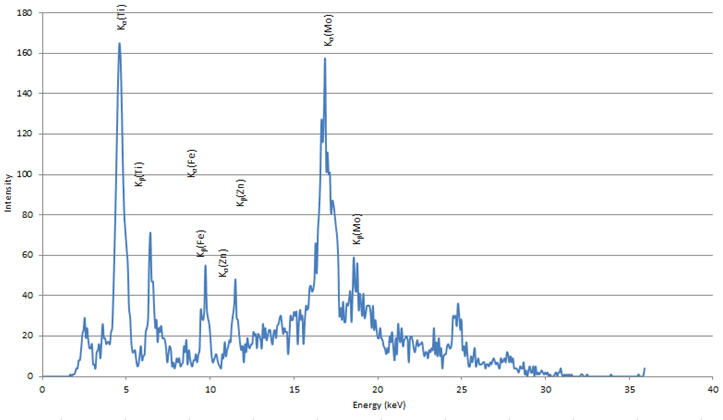X-Ray Fluorescence Spectroscopy
The first step in the analysis of the sample is the production of an X-ray, formed in a source which contains a wire (often tungsten) and an anode. A cathode releases electrons which accelerate towards the anode where they impact, resulting in to emission of an X-ray.
When the X-rays strike the material under analysis, they can either be absorbed by atoms or scattered. If absorbed, the X-ray transfers all of its energy to the innermost electron of an atom. This is known as the photoelectric effect. Provided the X-ray has adequate energy, electrons are then ejected from the inner shells of the atom, thus creating vacancies in the electron orbitals. In order for the atom to return to an electronically stable state, outer electrons transfer to the inner shells, releasing X-rays in the process at wavelengths specific to the atoms present. This is known as X-ray fluorescence. These X-rays are characteristic to the particular element, and it is this feature that allows for elemental composition to be established. However as the atom is returning to its original stable state, it may sometimes transfer the excitation energy to one of the outer electrons, causing the electron to be ejected. This is referred to as an Auger electron, and can cause problems in detection in terms of competition.
The emitted X-rays are then detected. XRF instruments are typically one of two types; energy-dispersive (ED) or wavelength-dispersive (WD). EDXRF systems use semi-conductor-like detectors which, having received the emitted spectrum from the sample, transfer it into a histogram of numbers of counts against photon energy. WDXRF instruments use a crystal to disperse the emitted photons depending on their difference wavelengths, placing the detector in a particular location to receive X-rays of a specific energy. The output of the instrument will often consist of a spectrum displaying a number of peaks of varying intensities.
Forensic Applications
X-ray fluorescence is a particularly beneficial tool to forensic scientists for a number of reasons. It is a non-destructive technique and the sample is left intact after analysis, particularly advantageous if the amount of sample is limited or further analysis is required. Naturally in forensic science there may be only a limited amount of sample recovered. Compared to certain other analytical techniques it is fast, requiring very little sample preparation as material can often be analysed as is (perhaps requiring homogenisation first) and producing results in minutes, thus multiple analyses can be carried out in a shorter space of time. Furthermore, portable XRF devices have been developed which can allow for analysis in-situ, potentially enabling instant results at the incident scene and additionally beneficial in the analysis of samples which cannot easily be removed from the scene. However a fairly large sample size is typically required for XRF spectroscopy.
This instrument has a wide range of potential applications to forensic science. It is particularly beneficial in the analysis of rocks, soils and other similar substances, allowing the analyst to compare the composition of these samples. This could be used in suggesting whether two similar-appearing soils are likely to have originated from the same source or if they are different, based on the various elements detected.
The technique can be used in the detection of counterfeit coins. Genuine coins are made up of very specific amounts of each component, for instance, the British one pound coin is composed of 70% copper, 24.5% zinc and 5.5% copper. Any one pound coin that is not made up of this combination of elements is likely to be a counterfeit, even if by appearance it is identical to a genuine coin. This is not limited to the analysis of potentially counterfeit coins, as counterfeit notes/bills can also be subjected to XRF spectroscopy.
Inks and paints are particularly suitable for analysis by XRF techniques, as they typically contain metallic pigments which can differ wildly between different brands and batches. The forensic analysis of writing and printer inks can be of particular importance in the investigation of questioned documents, for instance in aiming to establish whether two documents may have been written using the same ink.
The identification of gunshot residues can also be achieved using this technique. When a gun is discharged, minute particles from the firearm, bullet and gunpowder are propelled from the weapon, often onto the hands and clothing of the shooter. As the composition of gunshot residue is reasonably well documented and composed of compounds that are not typically present on a person’s hand, XRF can be applied to a piece of clothing or even an individual’s body to ascertain if such residues might be present, indicating whether or not they could have fired a weapon recently.
The ability of XRF to produce an elemental fingerprint of a sample is by no means limited to the aforementioned types of evidence, but can be applied to a wide range of samples providing they can be subjected to this technique. Unfortunately this instrumentation is not necessarily readily available for use in forensic science.
Carlton College Science Education Reseource Center. X-Ray Fluorescence (XRF). [online] Available: http://serc.carleton.edu/research_education/geochemsheets/techniques/XRF.html
The University of Missouri Research Reactor. Overview of X-Ray Fluorescence. [online] Available: http://archaeometry.missouri.edu/xrf_overview.html

